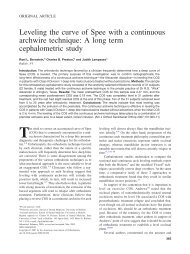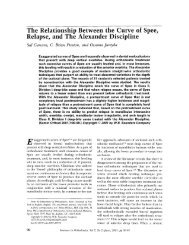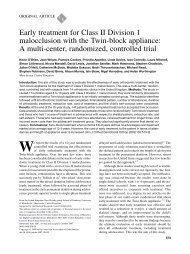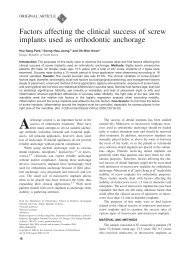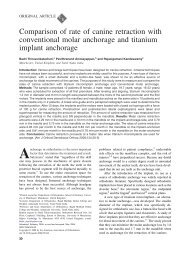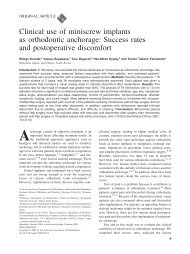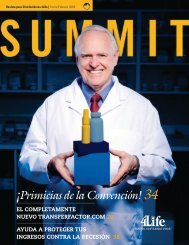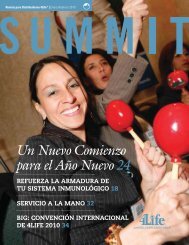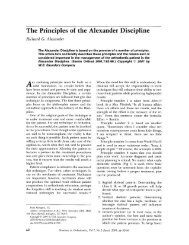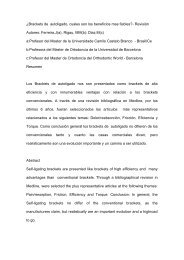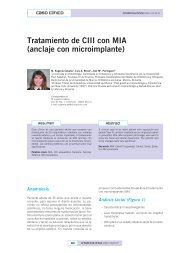Biomechanical and histological comparison of self-drilling and self ...
Biomechanical and histological comparison of self-drilling and self ...
Biomechanical and histological comparison of self-drilling and self ...
You also want an ePaper? Increase the reach of your titles
YUMPU automatically turns print PDFs into web optimized ePapers that Google loves.
48 Chen, Shin, <strong>and</strong> Kyung<br />
Fig 4. Fluorescent microscope views <strong>of</strong> middle part <strong>of</strong> peri-implant bone at first molar area<br />
<strong>of</strong> 1 dog’s m<strong>and</strong>ible: A <strong>and</strong> B, SDI; C <strong>and</strong> D, STI (100X original magnification).<br />
Table III. Comparison <strong>of</strong> BIC values between groups<br />
Group SDI STI<br />
Maxilla 39.28% (n 4) 27.96% (n 4)<br />
M<strong>and</strong>ible 47.44% (n 3) 26.35% (n 3)<br />
American Journal <strong>of</strong> Orthodontics <strong>and</strong> Dent<strong>of</strong>acial Orthopedics<br />
January 2008<br />
in the m<strong>and</strong>ible in the STI group. Removal torque, as a<br />
biomechanical method to measure anchorage or endosseous<br />
integration in which greater forces are required to<br />
remove microimplants, might be associated with increases<br />
in the strength <strong>of</strong> osseous integration.<br />
Compared with STIs, SDIs showed good resistance<br />
to shear force with bone growing into the threads <strong>of</strong> the<br />
microimplants. The secondary bone healing response<br />
resulted in biomechanical bone interlocking, which<br />
developed sufficient interface to resist shear strength<br />
<strong>and</strong> was sufficient to withst<strong>and</strong> orthodontic loads.<br />
However, there was no statistically significant difference<br />
in PRT between the 2 <strong>drilling</strong> methods. This<br />
chosen. STIs should be considered instead. In the<br />
maxilla <strong>and</strong> areas with thin cortical bone in the m<strong>and</strong>ible,<br />
microimplants would penetrate easily. Failure<br />
due to stripping <strong>of</strong> bone was infrequent, so pilot <strong>drilling</strong><br />
was not necessary.<br />
Heidemann et al<br />
19 reported the increase <strong>of</strong> PIT <strong>and</strong><br />
shearing forces on the screw it<strong>self</strong>; fracture <strong>of</strong> the<br />
screws was caused in thick cortical bone in their<br />
in-vitro test. Ellis <strong>and</strong> Laskin<br />
24 believed that, if a screw<br />
was stressed sufficiently in tension or torsion, it ultimately<br />
would be broken. They thought that, if screws<br />
were subjected to torsion <strong>and</strong> flexion stress, they would<br />
fail at a lower tensile stress value.<br />
This was validated by an in-vitro trial <strong>of</strong> screws<br />
with diameters <strong>of</strong> 0.8 to 2.0 mm; the screw diameter<br />
was the major predictor for holding <strong>and</strong> breaking<br />
strength. 26 23<br />
was supported by the results <strong>of</strong> Schon et in al which<br />
the PRT value <strong>of</strong> the SDIs was similar to that <strong>of</strong> the<br />
STIs at the same location: 4 Ncm in the maxilla <strong>and</strong> 12<br />
Ncm in the m<strong>and</strong>ible. The PRT values in the SDI <strong>and</strong><br />
STI groups might suggest that certain factors associated<br />
with microimplants stimulate in-vivo incorporation <strong>of</strong><br />
bone. Several previous investigations pointed out that<br />
removal torque measurement usually gave concomitant<br />
29-31<br />
results with histomorphometric evaluation <strong>of</strong> BIC.<br />
The authors <strong>of</strong> that study emphasized that As time went on, the PRT values in the SDI <strong>and</strong> STI<br />
the larger the diameter <strong>of</strong> the screw, the better its groups might be similar, <strong>and</strong> it was not expected that<br />
holding strength in thick bone.<br />
SDIs would have greater PRT values than STIs. In<br />
The use <strong>of</strong> reverse torque for measuring the shear contrast to previous reports,<br />
force required to rupture the bone-microimplant interface<br />
provided important information concerning bone<br />
growing into the fixture surface. Our PRT values were<br />
6.5 Ncm in the maxilla <strong>and</strong> 7.1 Ncm in the m<strong>and</strong>ible in<br />
the SDI group, <strong>and</strong> 5.7 Ncm in the maxilla <strong>and</strong> 6.1 Ncm<br />
27-30 our lower PRT values<br />
might be explained by the small size <strong>of</strong> the microimplants<br />
<strong>and</strong> the short observation time.<br />
It has been widely accepted that osseointegrated<br />
implants can provide absolute anchorage for tooth<br />
movement. The BIC value is a parameter for the linear



